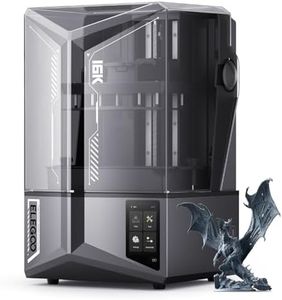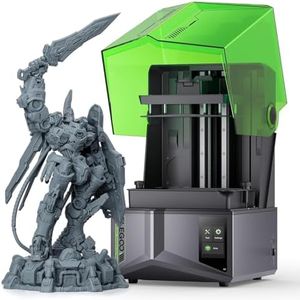We Use CookiesWe use cookies to enhance the security, performance,
functionality and for analytical and promotional activities. By continuing to browse this site you
are agreeing to our privacy policy
5 Best Resin Printers
From leading brands and best sellers available on the web.Buying Guide for the Best Resin Printers
Resin 3D printers are popular for their ability to produce highly detailed and smooth objects, which makes them great for applications like miniatures, jewelry prototypes, and dental models. When choosing a resin printer, you should focus not only on print quality but also on convenience and reliability. Since resin printing involves handling liquids and requires post-processing, you’ll want a machine that matches your experience level and your workspace. Understanding the key features and how they influence your printing experience will help you find the right printer for your needs.Print ResolutionPrint resolution in resin printers usually refers to the smallest detail the printer can produce, typically measured in microns (µm) along the X and Y axes (horizontal resolution) and layer height for the Z axis (vertical resolution). A lower micron value means higher detail, which is important for making intricate models. Desktop resin printers generally range from about 20 to 100 microns. If you care mostly about fine detail for models or jewelry, choose a printer with a lower micron value (20–50 µm). For less detailed, bigger parts, a higher value is acceptable and will also print faster.
Build VolumeBuild volume tells you how large an object you can print in one piece, described in length, width, and height (for example, 130 x 80 x 160 mm). If you plan to print big parts or several items at once, pick a printer with a larger build volume. For small items like miniatures, a smaller build volume will be enough and often means a more compact, easier-to-store printer.
Screen Type and LifespanResin printers use a screen (LCD or monochrome LCD) to cure each layer of resin. The screen type and lifespan affect both print performance and maintenance. Monochrome screens last longer and allow faster printing because they transmit more light, while color LCDs are slower and wear out faster. If you want to print often or value speed and lower long-term costs, look for a printer with a monochrome LCD screen.
Ease of Cleaning and MaintenanceUnlike filament 3D printers, resin machines require regular cleaning and careful handling because resin is messy and toxic before curing. Features like easily removable resin vats, washable components, and helpful tools make the process less demanding. If you’re new to resin printing or want less hassle, prioritize printers that are designed for easy maintenance and cleaning.
Connectivity and CompatibilityConnectivity options (USB, Wi-Fi, SD card) determine how you send print files to the printer. Simpler printers may use USB or SD cards, while others offer Wi-Fi for wireless transfer and remote monitoring. Also, consider if the printer supports third-party resins or only works with branded ones, as this can affect cost and flexibility. Pick the connectivity and compatibility options based on how you prefer to work and whether you want to experiment with various resin types.
Post-Processing RequirementsPrinted resin objects usually need to be washed (to remove uncured resin) and fully cured under UV light. Some printers are supported by a full ecosystem (like separate washing and curing stations), while others may need you to improvise with third-party solutions. If you value convenience or are just starting out, consider systems that simplify or automate the post-processing steps.






